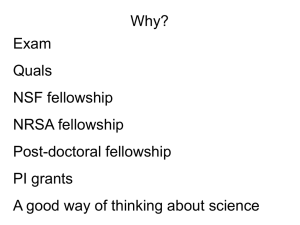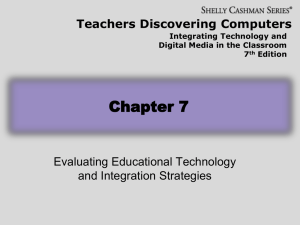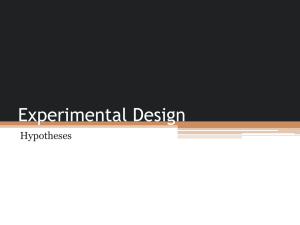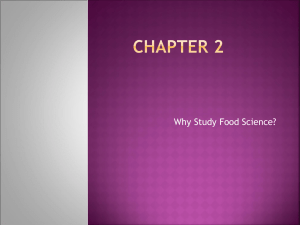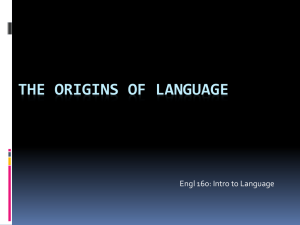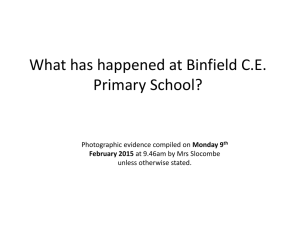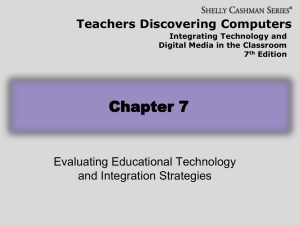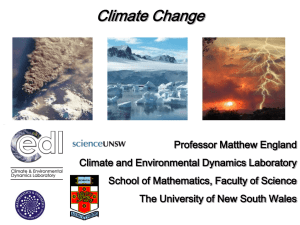01 Chapter - University Academy
advertisement
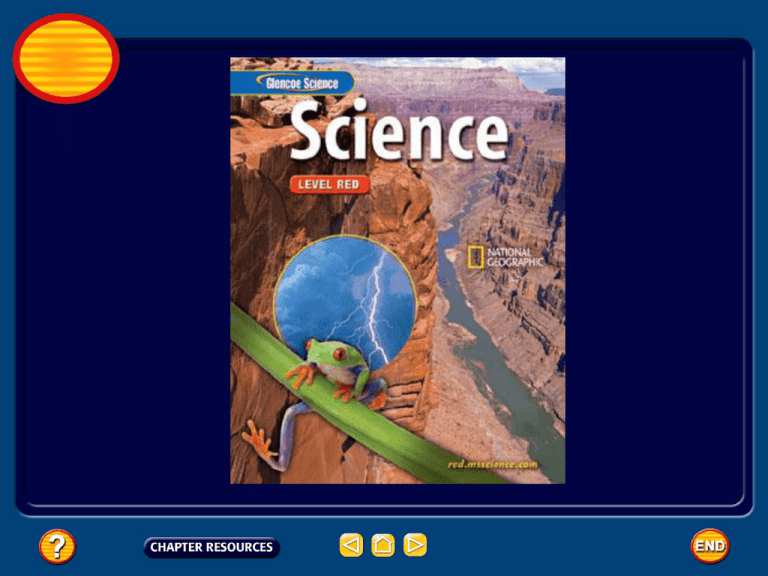
Table of Contents Chapter: The Nature of Science Section 1: What is science? Section 2: Science in Action Section 3: Models in Science Section 4: Evaluating Scientific Explanation What is science? 1 Learning About the World • Science is a way of learning more about the natural world. • Scientists want to know why, how, or when something occurred. • This learning process usually begins by keeping your eyes open and asking questions about what you see. What is science? 1 Asking Questions • Science can attempt to answer many questions about the natural world, but some questions cannot be answered by science. • Questions about art, politics, personal preference, or morality can’t be answered by science. • Science can’t tell you what is right, wrong, good, or bad. What is science? 1 Possible Explanations • Science can answer a question only with the information available at the time. What is science? 1 Possible Explanations • As new information becomes available, explanations can be modified or discarded and new explanations can be made. What is science? 1 Scientific Theories • An attempt to explain a pattern observed repeatedly in the natural world is called a scientific theory. • Theories in science must be supported by observations and results from many investigations. • They are the best explanations that have been found so far. What is science? 1 Scientific Theories • Theories can change. As new data become available, scientists evaluate how the new data fit the theory. • If enough new data do not support the theory, the theory can be changed to fit the new observations better. What is science? 1 Scientific Laws • A rule that describes a pattern in nature is a scientific law. • For an observation to become a scientific law, it must be observed repeatedly. • For an observation to become a scientific law, it must be observed repeatedly. What is science? 1 Scientific Laws • A law, however, does not explain why, for example, gravity exists or how it works. • A law, unlike a theory, does not attempt to explain why something happens. It simply describes a pattern. What is science? 1 Systems in Science • A system is a collection of structures, cycles, and processes that relate to and interact with each other. • The structures, cycles, and processes are the parts of a system, just like your stomach is one of the structures of your digestive system. What is science? 1 Systems in Science • Your school is a system with structures such as the school building, the tables and chairs, you, your teacher, the school bell, your pencil, and many other things. What is science? 1 Systems in Science • Your school day also has cycles. • Your daily class schedule and the calendar of holidays are examples of cycles. What is science? 1 Parts of a System Interact • In a system, structures, cycles, and processes interact. • Your daily schedule influences where you go and what time you go. • The clock shows the teacher when the test is complete, and you couldn’t complete the test without a pencil. What is science? 1 Parts of a Whole • All systems are made up of other systems. • The human body is a system—within your body are other systems. What is science? 1 Parts of a Whole • Scientists often break down problems by studying just one part of a system. • A scientist might want to learn about how construction of buildings affects the ecosystem. • Because an ecosystem has many parts, one scientist might study a particular animal, and another might study the effect of construction on plant life. What is science? 1 The Branches of Science • Science often is divided into three main categories, or branches—life science, Earth science, and physical science. • Each branch asks questions about different kinds of systems. What is science? 1 Life Science • The study of living systems and the ways in which they interact is called life science. • Life scientists can study living organisms, where they live, and how they interact. What is science? 1 Life Science • People who work in the health field know a lot about the life sciences. • Some other examples of careers that use life science include biologists, zookeepers, botanists, farmers, and beekeepers. What is science? 1 Earth Science • The study of Earth systems and the systems in space is Earth science. • It includes the study of nonliving things such as rocks, soil, clouds, rivers, oceans, planets, stars, meteors, and black holes. • Earth science also covers the weather and climate systems that affect Earth. What is science? 1 Earth Science • Meteorologists study weather and climate. • Geologists study rocks and geologic features. • A volcanologist is a person who studies volcanoes. What is science? 1 Physical Science • The study of matter and energy is physical science. • Matter is anything that takes up space and has mass. • The ability to cause change in matter is energy. What is science? 1 Physical Science • Physical science can be divided into two general fields—chemistry and physics. • Chemistry is the study of matter and the interactions of matter. • Physics is the study of energy and its ability to change matter. What is science? 1 Careers • Many careers are based on the physical sciences. • Physicists and chemists are some obvious careers. What is science? 1 Careers • Ultrasound and X-ray technicians working in the medical field study physical science because they study the energy in ultrasound or X-rays and how it affects a living system. What is science? 1 Science and Technology • Technology is the practical use of science, or applied science. • Engineers apply science to develop technology. • The study of how to use the energy of sunlight is science. Using this knowledge to create solar panels is technology. Section Check 1 Question 1 A rule that describes a pattern in nature is known as _______. A. a scientific theory B. a scientific law C. a scientific hypothesis D. a scientific rule Section Check 1 Answer The answer is B. A scientific law only recognizes that patterns exist in nature; it doesn’t try to explain why they exist. When you drop a rock, it always falls—thanks to the law of gravity. Section Check 1 Question 2 Studying how the sun makes energy is science. Putting this knowledge to use in making solar panels, however, is called _______. A. philosophy B. solar science C. technology D. the scientific method Section Check 1 Answer The correct answer is C. The term “technology” refers to the application of knowledge gained through the use of science. For example, understanding why natural gas burns is science; a gas-burning stove is technology. Section Check 1 Question 3 Which of the following questions cannot be answered by science? A. How old is the sun? B. How do volcanoes erupt? C. Should we be kind to strangers? D. Why is the sky blue? Section Check 1 Answer The answer is C. Moral questions cannot be answered by science. The other questions can be answered by the careful study of nature. Science in Action 2 Science Skills • Because no single way to gain knowledge exists, a scientist doesn’t start with step one, then go to step two, and so on. • Instead, scientists have a huge collection of skills from which to choose. Science in Action 2 Science Skills • Some of these skills include thinking, observing, predicting, investigating, researching, modeling, measuring, analyzing, and inferring. • Science also can advance with luck and creativity. Science in Action 2 Science Methods • Investigations often follow a general pattern. • Most investigations begin by seeing something and then asking a question about what was observed. Science in Action 2 Science Methods • To collect more information, scientists almost always make more observations. • They might build a model of what they study or they might perform investigations. • Often, they do both. Science in Action 2 Questioning and Observing • Ms. Clark placed a sealed shoe box on the table of the laboratory. • Everyone in the class noticed the box. • Within seconds the questions flew. Science in Action 2 Questioning and Observing • Investigations often begin by making observations and asking questions. Science in Action 2 Taking a Guess • “I think it’s a pair of scissors,” said Marcus. • “Aren’t scissors lighter than this?” asked Isabelle, while shaking the box. “I think it’s a stapler.” Science in Action 2 Taking a Guess • “What makes you think so?” asked Ms. Clark. • “Well, staplers are small enough to fit inside a shoe box, and it seems to weigh about the same,” said Isabelle. Science in Action 2 The Hypothesis • “A hypothesis is a reasonable and educated possible answer based on what you know and what you observe.” • “We know that a stapler is small, it can be heavy, and it is made of metal,” said Isabelle. Science in Action 2 Analyzing Hypothesis • “What other possible explanations fit with what you observed?” asked Ms. Clark. • “Maybe you’re overlooking explanations because your minds are made up.” • “A good scientist keeps an open mind to every idea and explanation.” Science in Action 2 Analyzing Hypothesis • “What if you learn new information that doesn’t fit with your original hypothesis?” continued Ms. Clark. • “What new information could you gather to verify or disprove your hypothesis?” Science in Action 2 Analyzing Hypothesis • “I know,” said Enrique. “We could get an empty shoe box that is the same size as the mystery box and put a stapler in it.” • “Then we could shake it and see whether it feels and sounds the same.” Science in Action 2 Making a Prediction • “If your hypothesis is correct, what would you expect to happen?” asked Ms. Clark. • “Well, it would be about the same weight and it would slide around a little, just like the other box,” said Enrique. • “It would have that same metallic sound when we shake it,” said Marcus. Science in Action 2 Testing the Hypothesis • “The stapler does slide around but it feels a little heavier than what’s inside the mystery box,” said Marcus. “What do you think?” he asked Isabelle as he handed her the box. Science in Action 2 Testing the Hypothesis • “What if we find the mass of both boxes? Then we’ll know the exact mass difference between the two,” said Isabelle. • Using a balance the class found that the test box had a mass of 410 g, and the mystery box had a mass of 270 g. Science in Action 2 Organizing Your Findings • “Before you draw any conclusions, let’s organize what we know. Then we’ll have a summary of our observations and can refer back to them when we are drawing our conclusions, ” said Ms. Clark. Science in Action 2 Drawing Conclusions • “The first thing that we learned was that our hypothesis wasn’t correct,” said Marcus. • “The boxes don’t weigh the same, and the box with the stapler doesn’t make the same sound as the mystery box.” Science in Action 2 Drawing Conclusions • “So you infer that the object in the mystery box is not exactly the same type of stapler, right?” asked Ms. Clark. • “To infer something means to draw a conclusion based on what you observe.” • “I guess we’re back to where we started,” said Enrique. Science in Action 2 Drawing Conclusions • “Do you know more than you did before you started?” asked Ms. Clark. • “We eliminated one possibility,” Isabelle added. Science in Action 2 Drawing Conclusions • “So even if your observations don’t support your hypothesis, you know more than you did when you started,” said Ms. Clark. Science in Action 2 Continuing to Learn • “Instead of giving up, you should continue to gather information by making more observations, making new hypotheses, and by investigating further.” • “Science takes patience and persistence,” said Ms. Clark. Science in Action 2 Communicating Your Findings • It is not unusual for one scientist to continue the work of another or to try to duplicate the work of another scientist. • It is important for scientists to communicate to others not only the results of the investigation, but also the methods by which the investigation was done. Science in Action 2 Experiments • Some questions ask about the effects of one factor on another. • One way to investigate these kinds of questions is by doing a controlled experiment. Science in Action 2 Experiments • A controlled experiment involves changing one factor and observing its effect on another while keeping all other factors constant. Science in Action 2 Variables and Constants • Variables are factors that can be changed in an experiment. Reliable experiments attempt to change one variable and observe the effect of this change on another variable. • The variable that is changed in an experiment is called the independent variable. Science in Action 2 Variables and Constants • The dependent variable changes as a result of a change in the independent variable. • It usually is the dependent variable that is observed in an experiment. • Scientists attempt to keep all other variables constant—or unchanged. • The variables that are not changed in an experiment are called constants. Science in Action 2 Laboratory Safety • In your science class, you will perform many types of investigations. • However, performing scientific investigations involves more than just following specific steps. Science in Action 2 Laboratory Safety • You also must learn how to keep yourself and those around you safe by obeying the safety symbol warnings. Science in Action 2 In a Laboratory • The most important safety advice in a science lab is to think before you act. • Always check with your teacher several times in the planning stage of any investigation. Science in Action 2 In a Laboratory • Make sure you know the location of safety equipment in the laboratory room and how to use this equipment, including the eyewashes, thermal mitts, and fire extinguisher. Science in Action 2 In the Field • Investigations also take place outside the lab, in streams, farm fields, and other places. • Scientists must follow safety regulations there, as well, such as wearing eye goggles and any other special safety equipment that is needed. Science in Action 2 In the Field • Never reach into holes or under rocks. • Always wash your hands after you’ve finished your field work. Click image to view movie. Science in Action 2 Why have safety rules? • Safety rules must be strictly followed, so that the possibility of an accident greatly decreases. However, you can’t predict when something will go wrong. Science in Action 2 Why have safety rules? • You always should wear and use appropriate safety gear in the lab—whether you are conducting an investigation or just observing. • The most important aspect of any investigation is to conduct it safely. Section Check 2 Question 1 A(n) ________ is a reasonable, educated guess, based on observations and grounded in what is already known. A. analysis B. conclusion C. hypothesis D. theory Section Check 2 Answer The answer is C. A hypothesis is more than just a stab in the dark. It is based on what you already know and what you observed. Section Check 2 Question 2 How many factors are changed in a controlled experiment? A. 1 B. 2 C. 3 D. 4 Section Check 2 Answer The correct answer is A. If more than one factor is changed, then you don’t know which one caused the result. Section Check 2 Question 3 What does this symbol mean? A. eye safety B. extreme temperature C. biological hazard D. sharp object Section Check 2 Answer The correct answer is D. There are many safety symbols you need to know before working in a lab. The symbol shown indicates that sharp objects may be used in the experiment and you should be careful not to cut yourself. Models in Science 3 Why are models necessary? • Just as you can take many different paths in an investigation, you can test a hypothesis in many different ways. • In science, a model is any representation of an object or an event used as a tool for understanding the natural world. Models in Science 3 Why are models necessary? • Models can help you visualize, or picture in your mind, something that is difficult to see or understand. • Models can be of things that are too small or too big to see. Models in Science 3 Why are models necessary? • They also can be of things that can’t be seen because they don’t exist anymore or they haven’t been created yet. • Models also can show events that occur too slowly or too quickly to see. Models in Science 3 Types of Models • Most models fall into three basic types— physical models, computer models, and idea models. • Scientists can choose to use one or more than one type of model. Models in Science 3 Physical Models • Models that you can see and touch are called physical models. • Examples include things such as a tabletop solar system, a globe of Earth, a replica of the inside of a cell, or a gumdroptoothpick model of a chemical compound. Models in Science 3 Physical Models • Models show how parts relate to one another. Models in Science 3 Physical Models • They also can be used to show how things appear when they change position or how they react when an outside force acts on them. Models in Science 3 Computer Models • Computer models are built using computer software. • You can’t touch them, but you can view them on a computer screen. Models in Science 3 Computer Models • Some computer models can model events that take a long time or take place too quickly to see. Models in Science 3 Computer Models • Computers also can model motions and positions of things that would take hours or days to calculate by hand or even using a calculator. • They can also predict the effect of different systems or forces. Models in Science 3 Idea Models • Some models are ideas or concepts that describe how someone thinks about something in the natural world. • Albert Einstein is famous for his theory of relativity. • One of the most famous models Einstein used for his theory is the mathematical equation E = mc². Models in Science 3 Idea Models • This explains that mass, m, can be changed into energy, E. • Einstein’s idea models never could be built as physical models, because they are basically ideas. Models in Science 3 Making Models • The process of making a model is something like a sketch artist at work. • Sketch artists attempt to draw a picture from the description given by someone. • The more detailed the description is, the better the picture will be. Models in Science 3 Making Models • Scientific models are made much the same way. • The more information a scientist gathers, the more accurate the model will be. Models in Science 3 Using Models • Not all models are for scientific purposes. • You use models, and you might not realize it. • Drawings, maps, recipes, and globes are all examples of models. Models in Science 3 Models Communicate • Often, it is easier to communicate ideas you have by making a model instead of writing your ideas in words. • This way others can visualize them, too. Models in Science 3 Models Test Predictions • Some models are used to test predictions. • Automobile and airplane engineers use wind tunnels to test predictions about how air will interact with their products. Models in Science 3 Models Save Time, Money, and Lives • Other models are used because working with and testing a model can be safer and less expensive than using the real thing. • For example, crash-test dummies are used in place of people when testing the effects of automobile crashes. Models in Science 3 Limitations of Models • The solar system is too large to be viewed all at once, so models are made to understand it. • Many years ago, scientists thought that Earth was the center of the universe and the sky was a blanket that covered the planet. Models in Science 3 Limitations of Models • Later, through observation, it was discovered that the objects you see in the sky are the Sun, the Moon, stars, and other planets. • This new model explained the solar system differently. • Earth was still the center, but everything else orbited it. Models in Science 3 Models Change • Still later, through more observation, it was discovered that the Sun is the center of the solar system. • In addition, it was discovered that other planets also have moons that orbit them. • A new model was developed to show this. Models in Science 3 Models Change • Earlier models of the solar system were not meant to be misleading. • Scientists made the best models they could with the information they had. • Models are not necessarily perfect, but they provide a visual tool to learn from. Section Check 3 Question 1 A meteorologist creates a program that predicts how a mass of cool air will interact when it hits a mass of warm air over the ocean. This is an example of a _______. A. computer model B. idea model C. physical model D. prototype model Section Check 3 Answer The answer is A. The meteorologist has used a computer to predict what the weather will be like. Section Check 3 Question 2 A paleontologist finds some scattered bones in the New Mexico desert. Carefully, she begins to reconnect them, filling in the missing spaces with clay. This is an example of _______. A. cell model B. computer model C. idea model D. physical model Section Check 3 Answer The correct answer is D. The paleontologist is creating a model that you can feel and touch. When she is finished, the model will give her a better idea of what the animal looked like and how it behaved. Section Check 3 Question 3 Physicists use a simple equation that describes the relationship between force, mass, and acceleration: f=ma. This equation itself is an example of a _______. A. computer model B. equation model C. idea model D. physical model Section Check 3 Answer The answer is C. While f=ma isn’t an object in space or an image on a computer screen, it still is a kind of model that helps us understand the world. f=ma Evaluating Scientific Explanation 4 Believe it or not? • Do you believe everything you read or hear? • Think of something that someone told you that you didn’t believe. • Chances are you looked at the facts you were given and decided that there wasn’t enough proof to make you believe it. Evaluating Scientific Explanation 4 Believe it or not? • What you did was evaluate, or judge the reliability of what you heard. • When you hear a statement, you ask the question “How do you know?” Evaluating Scientific Explanation 4 Critical Thinking • When you evaluate something, you use critical thinking. • Critical thinking means combining what you already know with the new facts that you are given to decide if you should agree with something. Evaluating Scientific Explanation 4 Critical Thinking • You can evaluate an explanation by breaking it down into two parts. • First you can look at and evaluate the observations. • Then you can evaluate the inferences—or conclusions made about the observations. Evaluating Scientific Explanation 4 Evaluating the Data • A scientific investigation always contains observations— often called data. • Data are gathered during a scientific investigation and can be recorded in the form of descriptions, tables, graphs, or drawings. Evaluating Scientific Explanation 4 Evaluating the Data • You should be cautious about believing any claim that is not supported by data. Evaluating Scientific Explanation 4 Are the data specific? • The data given to back up a claim should be specific. • That means they need to be exact. • When you are given specific data, a statement is more reliable and you are more likely to believe it. Evaluating Scientific Explanation 4 Are the data specific? • An example of data in the form of a frequency table is shown. • A frequency table shows how many times types of data occur. Evaluating Scientific Explanation 4 Take Good Notes • Scientists must take thorough notes at the time of an investigation. • Important details can be forgotten if you wait several hours or days before you write down your observations. Evaluating Scientific Explanation 4 Take Good Notes • It is also important for you to write down every observation, including ones that you don’t expect. • Often, great discoveries are made when something unexpected happens in an investigation. Evaluating Scientific Explanation 4 Your Science Journal • In science class, you will be keeping a science journal. • You will write down what you do and see during your investigations. Evaluating Scientific Explanation 4 Your Science Journal • Your observations should be detailed enough that another person could read what you wrote and repeat the investigation exactly as you performed it. Evaluating Scientific Explanation 4 Can the data be repeated? • Scientists require repeatable evidence. • When a scientist describes an investigation, other scientists should be able to do the investigation and get the same results. • The results must be repeatable. Evaluating Scientific Explanation 4 Evaluating the Conclusions • When you think about a conclusion that someone has made, you can ask yourself two questions. • First, does the conclusion make sense? • Second, are there any other possible explanations? Evaluating Scientific Explanation 4 Evaluating Promotional Materials • Suppose you saw an advertisement in the newspaper like the one shown. • What would you think? First, you might ask, “Does this make sense?” It seems unbelievable. Evaluating Scientific Explanation 4 Evaluating Promotional Materials • How was this claim tested? • How is the amount of wrinkling in skin measured? • You might also want to know if an independent laboratory repeated the results. • An independent laboratory is one that is not related in any way to the company that is selling the product or service. Evaluating Scientific Explanation 4 Evaluating Promotional Materials • Results from an independent laboratory usually are more reliable than results from a laboratory paid by the selling company. • It is important that you carefully evaluate advertising claims and the data that support them before making a quick decision to spend your money. Section Check 4 Question 1 The formal term for observations made during a scientific experiment is_______. A. conclusion B. data C. hypothesis D. theories Section Check 4 Answer The answer is B. When you evaluate a scientific claim you should examine the data. Is it given? Does it support the claim? Section Check 4 Question 2 When supporting a claim, you’ll want to have data that is _______. A. impressive B. new C. made up D. specific Section Check 4 Answer The answer is D. The data should be as specific as possible, weeding out generalizations that don’t really help explain the world. Section Check 4 Question 3 Suppose a person claims to have done an experiment that made him briefly invisible but says that it cannot be done again. You would not believe this person, because _______. Section Check 4 A. Credible scientific experiments must be repeatable. B. It isn’t possible to become invisible. C. No one has ever turned invisible before. D. You were not there to see the experiment performed. Section Check 4 Answer The correct answer is A. All scientific experiments must be repeatable before the results can be believed. Help To advance to the next item or next page click on any of the following keys: mouse, space bar, enter, down or forward arrow. Click on this icon to return to the table of contents Click on this icon to return to the previous slide Click on this icon to move to the next slide Click on this icon to open the resources file. Click on this icon to go to the end of the presentation. End of Chapter Summary File


